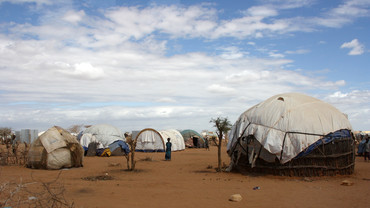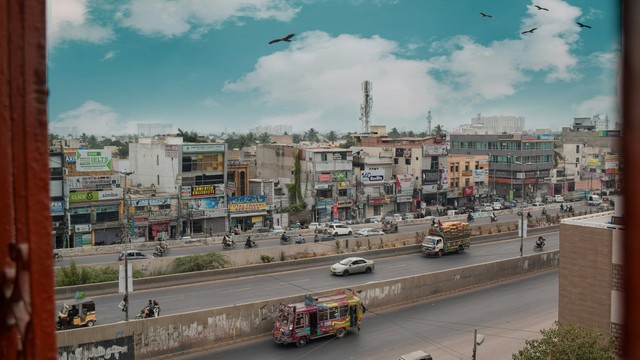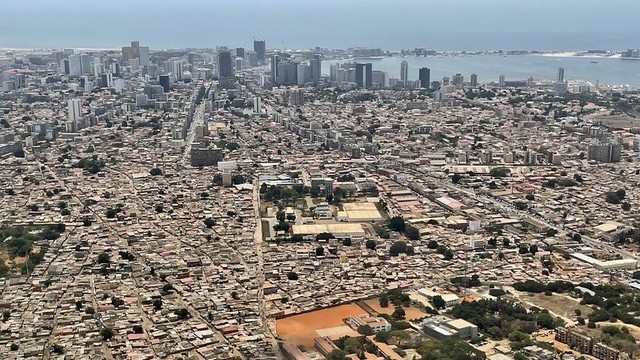Is the international community failing urban refugees and how do we fix this?
We look at dispelling the myths that stand in the way of concerted action to support refugees in their efforts to settle, integrate and contribute to the economic life of the city, while creating lives for themselves and their families.


Habibo, 38, came to Dadaab from a rural area in Somalia when she was 19. She keeps goats in her yard to make use of her skills as a pastoralist, but she dreams of living in a town or a city (Photo: Arete/Brian Ongoro/IIED)
Over the last four years, IIED has been partnering with researchers and civil society organisations in Kenya, Ethiopia, Jordan and Afghanistan to better understand protracted forced displacement.
Working with refugees and internally displaced people (IDPs), we compared their experiences of life in camps with life in cities – using household surveys, focus groups and qualitative interviews.
We sampled similar displaced populations across two sites in each country.
Location of interviewees in the 'Protracted Displacement in an Urban World (PDUW) project
Interviewees in camps and cities were carefully chosen to ensure equal attention to women and men. We also surveyed a smaller number of ‘hosts’ in each city.
We set out to test the hypothesis that refugees and IDPs have higher levels of wellbeing and better livelihood outcomes in urban settings, compared with camps. We also aimed to highlight where needs were not being met, and to work with city authorities and service providers to build understanding of the experiences of displaced people in their cities.
Challenging mainstream beliefs
A recently published IIED issue paper, ‘Why the international community is failing refugees: four myths about protracted displacement’, discusses stereotypes and received wisdom about urban refugees that we challenge through our research.
In brief, the four myths identified were that:
- Most displaced people in cities are self-reliant
- Refugees in cities are younger and better educated than those in camps
- Camps are safe havens offering a safety net for the most vulnerable, and
- Camps can evolve into stand-alone towns and cities providing long-term livelihoods and security for their residents.
While the messages and calls to action were aimed at UN agencies, international donors and organisations with a mission to protect displaced people, the myths also have resonance for city officials, leaders and service providers.
Beyond the stereotype
One of the myths assumes that refugees who have found their way to cities are better educated, younger and healthier than people in camps. Associated with this is the myth that they must be ‘self-reliant’ as they are fending for themselves without recourse to humanitarian assistance.
In reality there is a huge range of profiles among refugees. In Nairobi for example, there is a widely-held belief that Somali refugees are wealthy business people who own fancy cars and multiple properties. The Eastleigh neighbourhood, dubbed ‘Little Mogadishu’, has a thriving economy and real estate market, with close ties to Somalia and the wider diaspora.
While there are clearly many refugees and Kenyans of Somali origin who are successful entrepreneurs and traders, this is far from the case for all.
We discovered pockets of extreme deprivation, where refugees – notably women – have not had sufficient food in the past week. Women who work as street hawkers are particularly vulnerable, experiencing police harassment, and earning very little. Many are divorced, widowed or separated, and lack family and clan-based support networks. They struggle to provide for themselves and their children.
One of the crueller ironies faced by street hawkers, and other urban refugees with low incomes, is that when they request support from the UN, government officials or other authorities, they are frequently told to ‘go back to the camp’. But in many cases, refugees have left the camps or avoided them entirely, precisely because of hunger, homelessness and lack of opportunities to work and support their families. Many urban refugees have fled twice – first from conflict, and then from a camp.
Contrary to popular assumptions that camps provide a safe haven, our research shows that refugees there have lower levels of physical wellbeing than their counterparts in urban areas.
Refugees who left camps told us that they knew life in the city would be tough, but it was preferable to a life of enforced idleness, dependence on insufficient rations, and poor-quality healthcare and education. They spoke of being imprisoned or trapped in the camps, unable to leave or to provide a more hopeful future for their children.
Appreciate what refugees can contribute to the city
Many refugees and IDPs live alongside low-income households in informal settlements, and experience similar barriers to decent livelihoods and wellbeing. But they may be additionally vulnerable as a result of their status as displaced people.
Lacking correct documentation can be a real problem, but even those with up-to-date IDs face requests for bribes and experience arbitrary arrest and detention, particularly when at work.
Despite multiple obstacles, including restrictive policies on work and business registration, harassment and discrimination, our interviews revealed the determination of many urban refugees to remain in the city – often referring to it as being the only place where they can earn a living and provide a better future for their children.
Those who have managed to establish small enterprises speak with immense pride of what they have achieved, particularly when they are able to employ other refugees and local people from their host communities.
Next steps for refugee-hosting cities
In most parts of the world, refugee-hosting cities receive little or no support from the international community for providing services to displaced populations. Donors and UN agencies are aware of the urbanisation of displacement, frequently acknowledging that the majority of refugees live in urban areas. However, they wilfully fail to update their programming approaches in line with these demographic shifts, and leave large numbers of vulnerable refugees without assistance or protection.
A growing number of enlightened city officials recognise the benefits that cities can accrue from hosting refugees – in terms of their contributions to the economy through work and business. But extending basic services to additional populations comes at a cost.
Support from international agencies and institutions with a mandate to protect refugees could help bolster key services in hosting cities, to the benefit of all residents. Unfortunately, city stakeholders generally have very little say on national migration policies, and struggle to get their voices heard at international policy forums.
In both the African countries included in our study, Kenya and Ethiopia, recent changes to national legislation could open up greater freedoms and opportunities for refugees in cities. But this will require concerted advocacy on the part of civil society – and ideally the cities themselves – to achieve. It will also require a significant shift in attitude among national policymakers, who tend to view refugees as a security threat rather than an economic asset.
At the international level, as attention turns to the Global Refugee Forum in Geneva this month, there will be an opportunity for city mayors to address the UN’s refugee agency (UNHCR), its donors and other stakeholders, and emphasise the role they are already playing in responding to refugees.
Whether this can help to dispel the myths and shift deeply entrenched stereotypes about who urban refugees are, their need for assistance and their right to settle in cities, remains to be seen.
- Download: Why the international community is failing urban refugees: four myths about protracted displacement
- See a photo gallery to understand more about the lives of Somali refugee women living in Dadaab and Nairobi.





